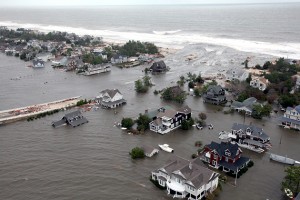Federal Flood Insurance Program in the Eye of the Storm

What’s the future of the federal flood insurance program?
The pun is purely unintended but that is what the shape of things with the National Flood Insurance Program (NFIP) is right now! And homeowners are a worried lot, especially after realizing the catastrophe that hurricanes like Katrina and Sandy are capable of unleashing. The irony of the situation is that although this program was initiated to grant affordable flood insurance coverage to homeowners living in flood-prone areas, it is the claims triggered by Katrina and Sandy that have put the program in debt.
Huge Debt
The widespread damage to homes caused by the Hurricane Katrina (August 2005) floods had exposed the shortcomings of the NFIP. The program was initiated in 1968 and until Katrina came along, it had been largely untested. Hurricane Katrina put it at in about $18 billion in debt, which was largely financed by borrowing from the Treasury. But things appear grimmer this time around; if that is possible.
A Paperwork Nightmare
According to reports in the New York Times, Hurricane Sandy is well on its way to become one of the costliest hurricanes in the history of the United States. And with 115,000 insurance claims filed till date and thousands more still to be filed, the NFIP is stretched beyond its capacity. Although President Barrack Obama had given the NFIP a new lease of life in 2012 by granting it a five-year extension, it seems that the program has stirred the hornet’s nest. This just shows you that depending on the government is not a prudent course of action. Many people believe President Obama should have spent more time on this issue rather than racking up huge tax bills on his lavish vacation in Hawaii but that is another story.
A Tug of War
Several reforms were proposed during the last extension of the NFIP, like doing away with the subsidies for non-primary residences, such as vacation homes, and properties that have repeatedly suffered severe damages from storms. While the pro-NFIP quarter is all for these reforms to be executed, the dissenters are crying hoarse to have the program privatized. The former group wants the program to be placed on a strong financial footing and the latter group is concerned about its debts and the burden it places on the Treasury. Meanwhile, the homeowners are awaiting with bated breath and much trepidation, the government’s decision.
Approximate Costs
It is noteworthy in this context that this federal flood insurance program makes participation mandatory for homeowners who have government-backed mortgages on their properties and live in flood-prone areas that run the risk of flooding at least once in a century. The average annual premium is approximately $615 but those who live in regions with greater risks are charged anything from $1,200 to $3,000.
These figures might just lull you into thinking that the billions of dollars that the government collects in annual flood insurance premiums is enough to bolster the finances and fortunes of the NFIP. But this is not the reality. In four years of the last decade, the flood insurance claims filed have vastly surpassed the total premium amount, sometimes by as much as close to $15 billion. So, the concerns regarding the burden of debt seem justified. But on the other hand, the case for privatization simply scares homeowners who know that private providers shy away from offering flood insurance coverage to homeowners but this is actually pretty rare and the system will be more efficient if it is privatized.
The future of the federal flood insurance program looks dicey and the average homeowner’s anxiety is understandable.
